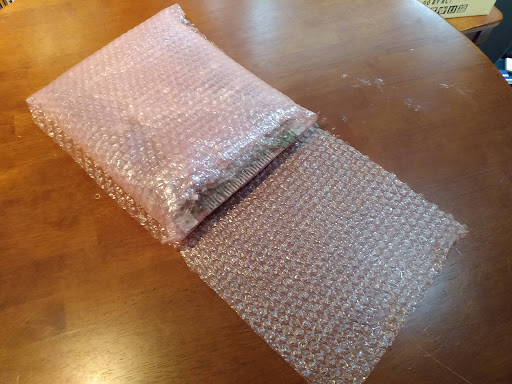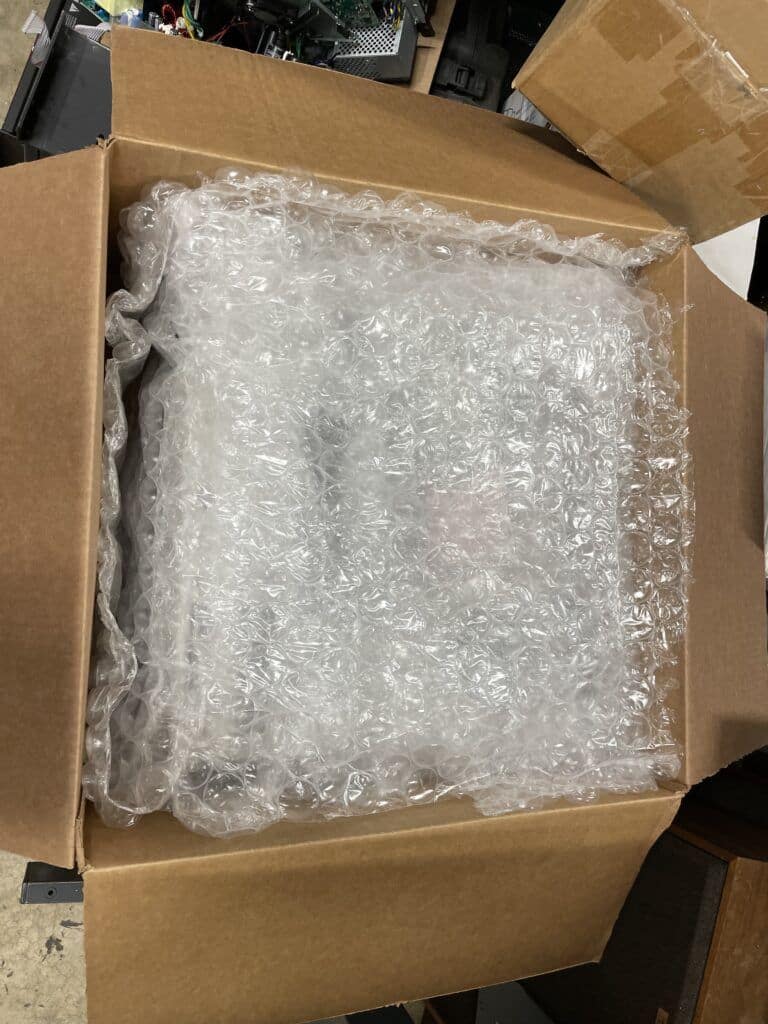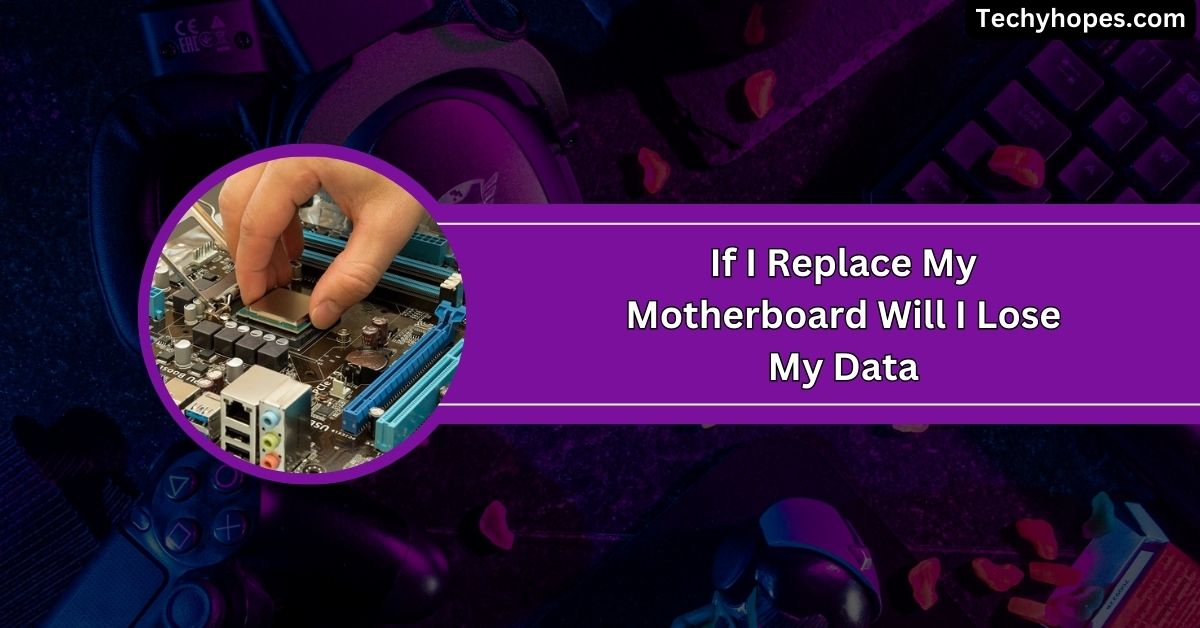Choosing the right materials is essential when safely packaging and shipping sensitive computer components like motherboards and CPUs.
Bubble wrap can damage a motherboard if wrapped too tightly, causing pressure on components. While it’s generally safe, tight wrapping or regular bubble wrap may lead to irreparable damage, especially to sensitive parts.
In this guide, we’ll explore the potential risks of using bubble wrap for electronics, provide tips on using it safely, and suggest alternative packaging materials to keep your components safe.
Understanding the Risks of Using Bubble Wrap
When protecting your motherboard, bubble wrap might seem like a good choice, but it’s not without risks. Let’s break it down and understand why.
- Static Electricity Can Be Harmful: Regular bubble wrap can create static electricity, which is dangerous for motherboards. Static shocks can damage the delicate parts and even stop the motherboard from working completely.
- Too Much Pressure Can Hurt: If you wrap bubble wrap too tightly, it can press on small parts of the motherboard. This might bend or break them, especially if the package gets bumped during shipping.
- No Protection From Moisture or Heat: Bubble wrap doesn’t guard against humidity or extreme temperatures. Too much moisture or heat can ruin the sensitive components of your motherboard.
- Not Designed for Electronics: Regular bubble wrap is great for protecting fragile items but unsafe for electronics unless paired with anti-static precautions.
How to Safely Use Bubble Wrap for a Motherboard

- Use Anti-Static Bubble Wrap: Always opt for anti-static bubble wrap instead of regular bubble wrap. This special bubble wrap prevents static electricity from forming, one of the biggest risks for electronics like motherboards.
- Start with an Anti-Static Bag: Place your motherboard inside an anti-static bag before using bubble wrap. This bag acts as a shield, protecting the sensitive electronic components from static shocks and keeping the motherboard safe.
- Don’t Wrap Too Tight: When wrapping the bubble wrap around the motherboard, ensure it’s snug but not too tight. Tight wrapping can create pressure points that damage fragile parts like capacitors and ports. Leave enough room for the cushioning to do its job without stressing the motherboard.
- Double-Box It for Extra Safety: Use a double-boxing method for added protection. First, put the wrapped motherboard in a strong box with padding around it. Then, place that box into a larger box with even more cushioning material, like foam or anti-static packing peanuts. This provides extra layers of security against both physical damage and static electricity.
- Add Labels and Instructions If Shipping: If you’re shipping the package, label it clearly as “Fragile” or “Handle with Care.” You can also include a note specifying the item is a sensitive electronic component so it gets handled appropriately during transport.
- Keep It in a Safe Environment: While preparing or storing the package, keep it in a dry, cool place. Avoid exposing it to high humidity or extreme temperatures, as these conditions can harm the motherboard.
Following these steps, you can safely use bubble wrap to protect your motherboard, ensuring it arrives at its destination without any damage.
Alternative Packaging Options for Motherboards
If you want to go beyond bubble wrap, several safer alternatives offer better protection for your motherboard:
- Anti-Static Foam: Anti-static foam is an excellent option for protecting your motherboard. Unlike bubble wrap, it won’t create static electricity. The foam cushions the motherboard while also preventing any harmful static buildup. It’s a great choice for both storage and shipping.
- Custom Foam Inserts: Custom foam inserts are tailored to fit your motherboard perfectly. They provide a snug, cushioned fit and prevent movement within the packaging. The foam also helps absorb shocks, offering strong protection during transit. This is one of the safest methods for ensuring your motherboard stays intact.
- Anti-Static Packing Peanuts: Packing peanuts with anti-static properties is another great option. They fill the empty spaces in the box, preventing the motherboard from shifting around. These peanuts are designed to prevent static electricity, providing an additional layer of safety for your electronics.
- ESD-Safe Containers: Electrostatic Discharge (ESD) safe containers are specifically made to protect sensitive electronics. These containers are designed to prevent static buildup and offer secure, cushioned packaging. If you want the most reliable protection, ESD-safe containers are a top choice for shipping and storing motherboards.
- Bubble Wrap with ESD Protection: While regular bubble wrap isn’t ideal, you can also use bubble wrap that has anti-static properties. This bubble wrap type minimizes static and provides the cushioning needed to protect your motherboard from physical damage during shipping.
Each of these alternatives offers better protection against static electricity and physical impact, helping ensure your motherboard arrives safely at its destination without risk of damage.
Common Mistakes to Avoid

- Using Regular Bubble Wrap Without an Anti-Static Bag: Always remember that regular bubble wrap can generate static electricity, which can harm your motherboard. Never use it without first placing the motherboard in an anti-static bag.
- Wrapping Too Tight: Avoid wrapping the bubble wrap too tightly around the motherboard. Tight wrapping can create pressure points and damage sensitive components.
- Overstuffing the Box: Packing the box with too much material can create excess pressure on the motherboard. Ensure enough padding, but don’t overstuff the box, which can lead to unwanted pressure during shipping.
- Ignoring Environmental Factors: Never store or ship the motherboard in extreme temperatures or humidity environments. These conditions can negatively impact the motherboard’s performance and longevity.
- Relying Only on Bubble Wrap: While bubble wrap is useful, relying solely on it may not provide the best protection. Always combine bubble wrap with protective materials like anti-static bags or custom foam inserts.
- Using Inadequate Packaging for Shipping: Avoid using flimsy boxes or insufficient padding for shipping. Always double-box and use strong, sturdy packaging materials to prevent physical damage during transit.
By avoiding these common mistakes, you can ensure your motherboard remains safe and secure, whether stored or shipped.
Also Read: Do Motherboards Come with Standoffs? – Learn The Truth!
Is Bubble Wrap Anti Static?
Regular bubble wrap is not anti-static. It can generate static electricity, damaging sensitive computer parts like motherboards and CPUs. To protect your electronics, use anti-static bubble wrap or place your items in anti-static bags before wrapping them.
Can You Put Bubble Wrap Inside A PC?
It’s not a good idea to put bubble wrap inside a PC. The wrap can cause static electricity buildup, harming the motherboard or other components. Always use anti-static materials when handling or storing your computer parts to keep them safe.
Can I Wrap My Pc In A Blanket?
Wrapping your PC in a blanket isn’t recommended. While a blanket can provide some cushioning, it won’t protect against static electricity or physical damage. Using anti-static bags and proper packaging materials is better for safe transportation and storage.
Does Bubble Wrap Damage A CPU?
Yes, regular bubble wrap can damage a CPU if it generates static electricity. This static can short-circuit the CPU’s sensitive components. Use anti-static bubble wrap or put your CPU inside an anti-static bag first for safe packaging.
Is Bubble Wrap Okay For Shipping A Motherboard?

Bubble wrap can be used to ship a motherboard, but only if it’s anti-static. Regular bubble wrap can cause static electricity, which might damage the motherboard. Wrap it in an anti-static bag before using bubble wrap for better protection.
Bubble Wrap Or Peanuts Inside A Computer For Shipping?
Both bubble wrap and anti-static peanuts can protect your computer during shipping, but anti-static peanuts are usually safer. They prevent static buildup while cushioning the computer parts. Bubble wrap is fine, too, as long as it’s anti-static.
CPU Upgrade Wrapped In Bubble Wrap, Worth The Risk?
Wrapping a CPU in regular bubble wrap is risky, as it may cause static damage. It’s safer to place the CPU in an anti-static bag first, then wrap it in bubble wrap. Protecting your upgrade is crucial to avoid costly damage.
You Should know: Motherboard Yellow Light: Tips To Diagnose & Fix The Problem
Best Thing To Wrap Computer Components In (If I Don’t Have Anti-Static Bags)????
If you don’t have anti-static bags, use anti-static foam or bubble wrap designed for electronics. These materials will protect your computer components from static damage. Avoid using regular bubble wrap, as it can create static that could harm the parts.
Got My Package Today, The Dude Shipped A Mobo In Bubble Wrap? Is That Safe?
Shipping a motherboard in bubble wrap can be risky if it’s not anti-static. Regular bubble wrap can cause static damage to the motherboard. It’s safer if the motherboard is placed in an anti-static bag before being wrapped in bubble wrap.
FAQs
1. Is it safe to wrap a motherboard in bubble wrap?
It’s only safe if you use anti-static bubble wrap. Regular bubble wrap can create static and damage the motherboard.
2. Is it OK to put bubble wrap inside a PC?
No, putting bubble wrap inside a PC can cause static damage. Always use anti-static materials to protect the components.
3. Can bubble wrap damage electronics?
Yes, regular bubble wrap can cause static electricity buildup, damaging sensitive electronics. Use anti-static bubble wrap instead.
4. Can you bubble wrap a CPU?
You can, but always place the CPU in an anti-static bag first to prevent static damage before wrapping it.
5. Is bubble wrap a bad insulator?
Bubble wrap isn’t a good insulator for electronics. It doesn’t properly protect against static, moisture, or extreme temperatures.
6. How do you wrap a circuit board?
Place the circuit board in an anti-static bag first, then wrap it gently with anti-static bubble wrap for added protection.
7. How durable is bubble wrap?
Bubble wrap is quite durable for cushioning, but it isn’t foolproof. It can’t protect against static without proper precautions.
8. Is it safe to use compressed air on a motherboard?
Yes, but use short bursts and hold the can upright to avoid moisture. Be gentle to avoid damaging components.
9. Can you ship electronics in bubble wrap?
You can, but only if the bubble wrap is anti-static. Regular bubble wrap can harm electronics due to static buildup.
10. How flammable is bubble wrap?
Bubble wrap is flammable. Avoid exposing it to heat or flames, as it can catch fire easily. Keep it safe!
Conclusion
In conclusion, while bubble wrap can protect your motherboard, it’s essential to use it correctly. Always choose anti-static bubble wrap, avoid tight wrapping, and consider alternative packaging options like anti-static foam for better protection. Prioritize safety to keep your components undamaged.





